My Trip to Egypt
Egypt had always been a place I wanted to visit for many reasons. Its influence on world history, specially in the areas of mathematics, astronomy, arts and religious thought has always fascinated me since childhood. During my previous trips with my wife to some countries along the Mediterranean coast, I was also able to witness these influences firsthand, especially in areas such as Mycenae and Crete. So, when I got an opportunity to travel to Egypt with my parents, I accepted without any hesitation.
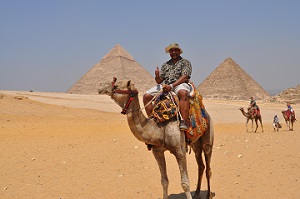
The 10-day tour offered by Trafalgar Tours called “Egyptian Voyageur” started and ended in Cairo. In between, we visited numerous places of archaeological significance within the country including Abu Simbel, Aswan, Luxor, Kom-Ombo, Edfu and Alexandria. We were accompanied by other tourists from Australia, New Zealand and the United States. During the tour, we also managed to take in the full “Egyptian experience” by travelling on the Nile for nearly 5 days as well. After the tour, we spent a few extra days in Cairo before my parents departed back to India, and I flew home to Canada.
We write to taste life twice, in the moment and in retrospect. ~ Anaïs Nin
Cario - Visit to the Pyramids and Museum
It was early July when I flew to Egypt from Canada via Toronto, and then through Frankfurt. I had bought a book on Egyptian history titled “A History of Egypt: From Earliest Times to the Present” written by Jason Thompsonin preparation for this trip. However, my plans to read this book before the trip never materialized as I had absolutely no leisure time during the few weeks leading up to the trip. So, I had to start the book on the plane. This is a well written book and covers the history of Egypt right from Palaeolithic times to the present. The 15-hour journey allowed me to read and absorb nearly half of the book by the time I had reached Cairo.
As our plane neared Egypt, we could see the Nile Delta dotted with a mix of sandy as well as green islets. On both sides of the Delta is a nearly endless ocean of sand bounded only on its northern edge by the blue Mediterranean Sea. After the plane landed, and as I walked on the tarmac, the hot, dry and biting wind reminded me that I was in a completely different climatic region of the world; one that was very different from the prairie region of Saskatchewan that is home for me these days.
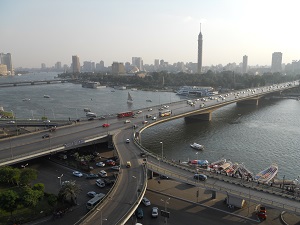
Due to a small mix up, I would miss my pick up at the airport and instead cab it to the hotel where my parents and other travellers in the tour were staying (“Ramses Hilton”). There, I would find out much to my dismay that I had paid nearly three times the normal cab fare for my ride. :-) This incident was only the beginning of some bitter experiences that my fellow travellers and I would go through during the trip. Egypt has some of the friendliest people in the world, and yet the economic conditions that its people are forced to live in everyday also make it one of the most stressful places for the tourists who are nagged almost constantly to buy things or give unnecessary tips. I really hope that the uprising that occurred that started only a few months after I was there, as well as the subsequent change in leadership, brings more peace and prosperity to this beautiful country. My parents arrived in Cairo a few hours later, and we spent the evening chatting and catching up. We knew our first day was packed, and so retired to bed early to ensure we were well rested for it.
The next morning, after some briefing by our tour guide as well as some paperwork, we boarded the bus to visit the Egyptian Museum. Although not a huge museum by world standards, this museum houses some of the most priceless treasures of Egyptian archaeology including artifacts discovered from King Tutankhamen’s tomb as well as artifacts collected from nearly every part of Egypt. Our tour guide did a great job of explaining the differences in styles of the various sarcophaguses (or “sarcophagi”) that were displayed here as well as on other burial customs/habits ranging from the time of the first pharaohs of the Old Kingdom right up to the time of the last pharaohs from the Ptolemaic dynasty.
There were many other highlights for me at this museum. We saw mummified remains of numerous animals that the ancient Egyptians held as sacred including large Nile crocodiles and baboons. There were also numerous artifacts belonging to the common citizen of ancient Egypt. These included furniture, cooking utensils, clothing as well as fishing and agricultural tools. Unfortunately, no photography was permitted inside the museum, and so, I couldn’t bring any of these memories back home except for those in my head.
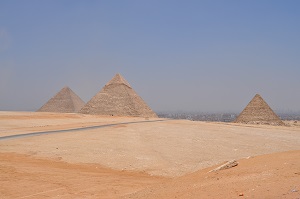
After a tour of the museum, and later a short break at the adjacent cafeteria, we boarded the bus and proceeded towards one of the seven wonders of the ancient world, the Great Pyramids at Giza. Even from Cairo, one can see these pyramids towering over the adjacent landscape. Our tour guide mentioned that there were over a hundred pyramids that have been discovered in Egypt alone. Most of these were constructed during the early period of the pharaohs. Pyramid construction stopped during the New Kingdom period predominantly for two reasons: costs involved as well as due to frequent looting as they were highly visible targets. The great statue of the Sphinx stands at the entrance of the pyramid complex, and it was a towering sight. Standing up close, I could finally understand why it has been featured some prominently in popular imagination. There is a temple complex around the Sphinx, and my tour group wandered around here taking pictures before heading to see the pyramids.
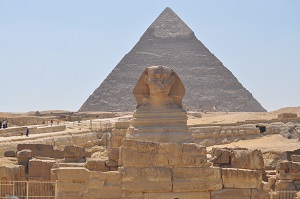
There were three large pyramids at Giza (the largest called the “Pyramid of Khufu” or the “Pyramid of Cheops”). Taking our guide’s suggestion, few other tour members and I chose to go inside the second pyramid (called the “Pyramid of Khafre”). Being inside the pyramids was very claustrophobic indeed. The pyramids are estimated to weigh in the millions of tons, and I couldn’t help thinking about this fact as I walked through an extremely narrow tunnel with almost no ventilation or light inside. We were only inside for about 15 minutes. Since we were not allowed to take any pictures inside, I took in whatever sights I could and came back outside with the others. Outside, there was very little shade anywhere. Temperatures had soared to nearly 44 degree Celsius that day, and I was constantly drinking water every 20 minutes or so. From Giza, we made our way back to our hotel by 5 pm. We had to catch a plane the next morning, and so, I was off to bed early but not before I watched a cool Egyptian action movie on the television in my hotel room.
Aswan, Felucca Ride and Entertainment
As our plane approached Aswan, we could see the famous Aswan Dam (also known as the “High Dam”) from the air. Built from the 60s through the 70s, this dam plays a key role in both farming as well as energy requirements for the country. The construction of this dam effectively discontinued the type of farming which relied on the annual flooding of the Nile. Although some argue that the newer farming practices use intensive fertilizers leading to more pollution, the availability of water year around has helped Egypt increased its agricultural output many fold. We stopped half way across the dam and stopped to take photographs of the dam as well as hydroelectric plant adjacent to it.
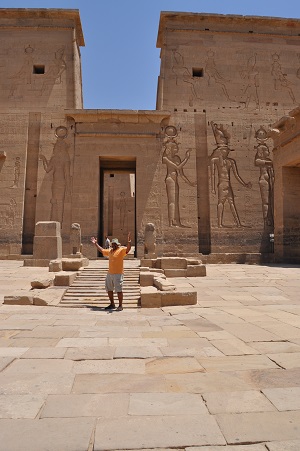
After we checked our belongings into our cruise ship which would be our home for the next 5 days, we took a motorboat to the visit the famous temple of Isis located on the island of Agilkia. This beautiful temple was one of the many built during the rule of the Ptolemic dynasty. Although of Greek and Macedonian in ancestry, the Ptolemies adopted the Egyptian religion and became big patrons of many temples to garner support from the powerful priests and the Egyptian population. This temple also received support from many emperors during Roman rule but was finally closed on the order of Emperor Justinian in the 5th century AD. Apparently, this is the last place where the ancient hieroglyphic script was used before its use was discontinued. Walking through the temple complex, it was hard for me to believe that this entire temple complex which once stood on the now submerged island of Philae was dismantled and later reassembled on higher ground during the construction of the high dam. We spent several hours touring the beautiful temple complex before we made our way back to the cruise ship for lunch.
After lunch, some of the tour members including my parents and I took the optional tour on the Nile felucca as well as visited a Nubian village. A felucca is a wooden sailboat that has been in use along the Nile since the time of the Pharaohs. Although slowly being replaced by motorboats, it is still quite popular among locals as well as tourists. The breeze along the river was refreshing, and I couldn’t help but think about the all the traffic that must have flowed along this river since the ancient times. We transferred to a small motorboat after the sail and visited a small Nubian village about 5 miles from Aswan.
The Nubians were once part of a rich and powerful kingdom which was both culturally and militarily significant in Africa. Being rich in natural resources such as gold, ivory, copper, frankincense and ebony meant that this land was much sought after and fought over almost continually throughout history. Although most Nubians live in Sudan, many live in Egypt. Nearly 100,000 Nubians had to be resettled by the Egyptian government further to the flooding of the Nile valley to create lake Nasser during the construction of the high dam. After the tour of this village and buying some small handicraft created by some of the villagers, we made our way back to the cruise ship.
That evening, my parents and I sat in the company of some avid history lovers and had some very interesting conversations. However, I also had to get up very early the next day to leave with just a few other tour members to fly to Abu Simbel, and so, I was off to bed a little earlier than I liked to.
Abu Simbel, Kom-Ombo, Edfu, Karnak and Luxor Visits
Next morning, we flew from Aswan about two hundred kilometres south to Abu Simbel. This region is very close to the border of Sudan and is famous for its two very large rock temples. This temple complex was also relocated from a different site that was to be submerged under water due to the construction of the High Dam thanks to the efforts of UNESCO. They were built during the reign of a mighty Pharaoh called Ramesses II to commemorate his victory over the Hittites. The large temple is dedicated to the great Pharaoh, and small one was dedicated to his wife and queen, Nefertari.
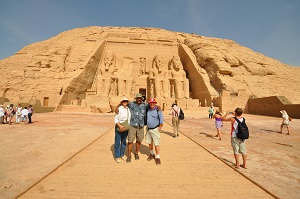
There are colossal statues in front of the large temple featuring the Pharaoh, his wife as well as his sons. Inside, there were incredible rock carvings depicting various scenes from the battle. Even at ten o’clock in the morning, the temperatures had soared to nearly forty degrees Celsius, and it was quite warm inside. So, I couldn’t stay inside too long. After touring the inside of both temples, we took in a quick tour of other parts of the temple complex which included a nice garden with a winding walk way. We then made our way back to the shade of the shopping tents and the many mist fans inside which helped provide a much-needed relief from the heat. I spent about an hour here chatting with a pair of friendly Australians who were touring Egypt. When other members of my tour had all reunited in this tent, we then made our way back to the airport to return to Aswan. A great buffet lunch that awaited us at the cruise ship, and I enjoyed narrating the details of this optional trip to other members of my tour group who had opted not to go.
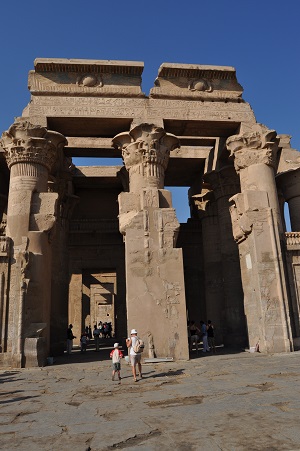
Later that afternoon, we sailed further to dock near the temple of Kom-Ombo dedicated to the Crocodile God, Sobek. This temple is very beautiful in architecture and was built during the reign of the Ptolemic dynasty and is adjacent to the Nile river. Although this temple had lay in ruins due to being flooded and partly due to vandalism, it has been restored to a moderate extent. Huge crocodiles once lived in specially constructed water tanks within this temple complex, and according to the tour guide (seen on the left here). many large animals routinely became sacrificial offerings to these crocodiles here. After a tour of this temple complex, we made our way back to the ship for another great evening which included a sumptuous meal and some entertainment after which featured local musicians as well as many Nubian dancers.
The next morning, we made our way to Edfu, one of the largest (second only to the temple at Karnak) and the most well preserved Egyptian temples dating back to the Ptolemic dynasty. Even from a distance, you could see the towering walls that surrounded the vast temple complex. Much like the temple of Philae, this temple also was abandoned during Roman rule. The orders for the closure came during the reign of Emperor Theodosius who banned all non-Christian worship within his empire. The inscriptions on the walls and pillars are well preserved. This temple has numerous chambers dedicated to the pantheon of gods and goddesses of ancient Egypt, and is a must see for anyone visiting Egypt.
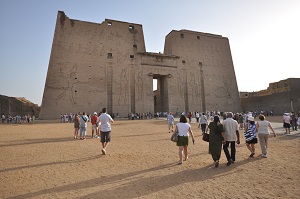
Two fascinating facts for me about Edfu were: 1) the presence of special escape tunnels for the priests which would enable them to escape in the case of an attack, and 2) the special effects that are created by the innovative use of sunlight inside the chambers to create a sense of awe and mystery for the pilgrims who came to pray here. As we toured the outside of the temple, our tour guide also pointed out numerous heaps of pottery shards which were apparently left behind by pilgrims who had come to pray here.
After we returned to the ship, we cruised farther along the river to reach Luxor. This temple is close to the Nile and was built by King Amenhotep III and is dedicated it to Amon-Re, his wife Mut, and their son Khons. Many Pharaohs contributed to the extension and development of this temple complex, notably Tutankhamen and Ramses II. There is also a shrine here dedicated to the Macedonian king, Alexander the Great. Besides the giant pillars in this temple complex, one cannot miss the giant red granite obelisk which towers over the rest of the temple complex. Apparently, there were two of these until the 18th century when one of them was gifted to France by the ruling Egyptian sultan. The tip of the obelisk was once covered with a sheet of gold and caused a brilliant reflection of the sun light.
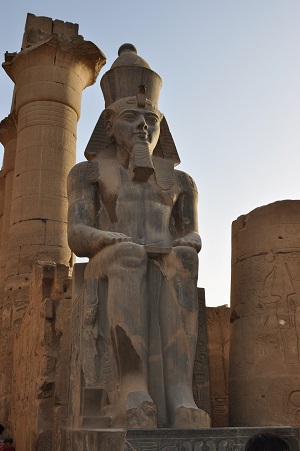
At night, a special light show accompanied by ancient Pharaonic chants and other Egyptian music is organized for the tourists at this temple. But, my tour group and I missed seeing it as the show was cancelled that evening due to technical difficulties. We returned to the ship that evening, and after supper spent nearly four hours chatting with some tour members on the deck. It was a full moon that night, and it ended up being a memorable evening as we chatted on a range of historical topics which covered the Middle East, India and China. This is one of the main reasons why touring with others has been so rewarding for me.
The next morning, we had breakfast very early in the morning, and said good bye to the ship’s crew as it was the end of our 5 day Nile cruise. We left for the famous temple of Karnak first. Once, the temple of Luxor and the temple of Karnak were selected by a pedway hundreds of metres long, lined on both sides by statues. But the pedway and most of the statues are all gone. We had a group photo at the entrance to the temple, and later entered the temple complex. This temple complex is considered the second most famous tourist site in Egypt, and I would quickly find out why.
This temple was constantly renovated and expanded during the reign of the Pharaohs, and according to our tour guide, nearly all Egyptian pharaohs had contributed to the renovations here. Besides being architecturally significant, it also provides a great insight into ancient Egyptian beliefs as one could see a progression of religious beliefs through the figures of gods and goddesses depicted here. The hypostyle hall was a major highlight for me which featured hundreds of huge pillars and the beams erected on these pillars. I stared in disbelief at the thought of all the manpower and the engineering that must have been required to erect these structures thousands of years ago. One of tallest Egyptian obelisks is also situated here, and apparently it was transported here from a quarry some distance away using boats on the Nile.
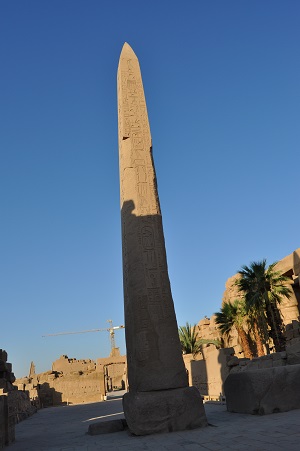
Valleys of the Kings, Deir el-Bahri and Cairo
From Karnak, we then headed to the famous Valley of the Kings by bus. This is a special valley in Egypt where tombs were constructed for the kings of the New Kingdom. This entire area has become very famous due to the discovery of the tomb of Tutankhamen and the accompanying rumours of the “Curse of the Pharaohs” that were brought into the popular imagination by Hollywood. This site was declared as a World Heritage Site in the 70’s.
On the way to the Valley of the Kings, we stopped briefly a the Colossi of Memnon. Although mistaken for most of history as a dedication to one of the heroes of the mythical Trojan wars, these two giant statues towering some twenty metres were in fact dedicated to Amenhotep III. There was once a huge temple complex here that stretched nearly 40 hectares, but these two statues are all that remain now.
From here, we made our way to Deir el-Bahri. This is the site of Queen Hatshepsut’s very majestic temple. This is a beautiful temple, and was constructed during the reign of a lady Pharoah near the Valley of the Kings. Hatshepsut reign was during the New Kingdom period of the Egyptian history, and was succeeded by her nephew/stepson Thutmosis III. Hatshepsut commissioned many works during her reign, and the architect of most of these works was her lover, Senenmut. When Thutmose III ascended the throne, he had all her images chiseled off throughout the temple. Almost all record of her reign were lost until recent discoveries by archaeologists.
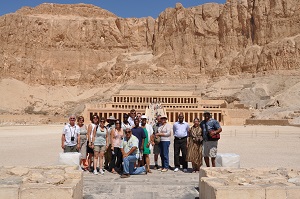
After a tour of this temple, we made our way to the Valley of the Kings. During the later period of Egyptian Pharaohs, the tradition of pyramid construction for burial of Pharaohs ceased almost completely as they became highly visible/easy targets for tomb robbers. A number of famous Pharaohs are buried at the Valley of the Kings including Ramses I and II, Thutmose III and IV as well as Tutankhamen. There was very little breeze here making the temperatures around the region extremely hot during the day. After a tour of a number of tombs including that of Ramses II and Tutankhamen, we made our way back to the bus. From here, we left for Cairo on a plane.
I spent the remainder of the day in Cairo with my parents in our hotel rooms watching TV and chatting. We went to a nice Indian restaurant situated within the hotel, and had a great supper. I returned to my room after and watched an Egyptian movie before going to bed. The next morning, we had breakfast and headed to Alexandria. On the way, we stopped at a market to buy water, fruits and nuts to snack on during the rest of the trip.
Wadi El Natrun, Alexandria and Surrounding Areas
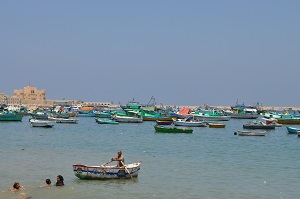
Alexandria is a famous city founded along the Mediterranean sea by Alexander the Great, and has played a significant role in the areas of international trade, astronomy, mathematics, science, arts, philosophy and religious thinking. It shined a lighthouse of intellectual thought and scientific progress for nearly seven hundred years until it was eclipsed by Constantinople (now “Istanbul”). This was the place that had captured my imagination the most among all places I knew in Egypt, and had been most eager to visit this great city. It did not disappoint even a tiny bit. We visited numerous places here including the Kom Elshokafa Catacomb, the National Museum, El Morsi Abu El Abbas Mosque and a had a tour of downtown Alexandria as well.
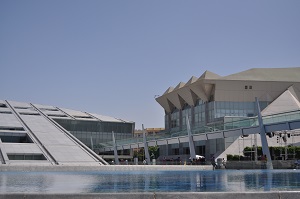
The Alexandria National Museum is a must-see for any tourist interested in history. It contained thousands of artifacts ranging from Pharaonic, Roman and Islamic periods. The highlights for me were the mummies displayed underground in specially lit chambers as well as the numerous artifacts recovered from underwater near Alexandria belonging to the Greco-Roman period.. Although I wanted to visit the famous library of Alexandria, we simply ran out of time.
We stayed at the famous Montazah Palace and Gardens which was one of the former homes of the Royal family when Egypt was still ruled by a monarchy. We had a group supper at a nice restaurant which overlooked the sea. That night, I sat out in the balcony and finished the last chapter of the book that I had brought with me. I felt more connected with Egypt as a result of reading this book as I could appreciate what I was seeing even better. I also made a commitment to myself that I would repeat the same pattern of taking a history book with me if I toured any other place from this point on.
Next morning, we drove back to Cairo. On the way, we stopped at a Coptic Monastery at Wadi El Natrun. This monastery has been in existence for nearly fifteen hundred years. The monastery has been continuous use throughout this period although it had suffered repeated attacks from the Bedouin and the Berber people. The monks here were extremely friendly, and were very happy to show us around this monastery. Although I am not religious myself, I could not help but feel a sense of tranquility while we were here.
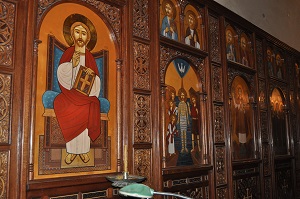
One of the most fascinating aspects of the Coptic religion is that their language is a direct descendent of the language of the Pharaohs. I asked one of the monks if he could read one of their holy books to get a sense of what ancient Pharaonic must have sounded like, and felt transported back in time listening to this ancient language. We spent about three hours here, and after a tour of the many churches inside, we made our way back to the bus and headed to Cairo.
As we pulled into Cairo, we stopped at a perfume factory in Giza. Egypt exports flower extracts worldwide to be used in the manufacture of perfume. This stop provided an opportunity to sample a rich variety of these flower extracts. We also stopped at a papyrus factory after, and were shown the process of manufacturing papyrus which has featured so prominently in the cultural history of ancient Egypt. We also were shown a very impressive collection of paintings, and I picked up a couple of small pieces as souvenirs. From here, we made our way back to the hotel.
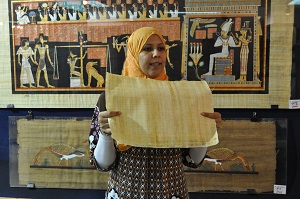
This was to be the last leg of our journey, and I was somewhat sad that this stimulating trip had come to an end. Hotel Concorde, where we stayed, is situated relatively close to the Cairo airport, was a great relaxing place to stay even if it was only for two nights. The tour group and I said our good byes as we got off the tour bus. I had some laughs with our tour guide, Muhammed, who had kept us all entertained throughout the trip. We talked about other places to visit if I ever made it to Egypt again in the future. Most of my tour group flew back to their respective countries the next morning. However, my parents and I stayed an extra day to allow us to spend time with each other. We also spent some time doing some last minute shopping for souvenirs to bring back to our homes.
Summary
Overall, I loved almost every aspect of this trip from the type of accommodation we had, the choice of places we visited as well as the knowledge and temperament of our tour guide. The highlights of the trip for me were visiting the Great Pyramids at Giza, Abu Simbel, Edfu and Luxor. My only disappointments were not being to visit the famous library at Alexandria as well as not finding the time to visit the pyramid at Saqqara otherwise known as the “Pyramid of Djoser” (this is reportedly the first true step pyramid). I highly recommend this tour to anyone seeking to take in the big picture of the rich cultural and religious history of Egypt.